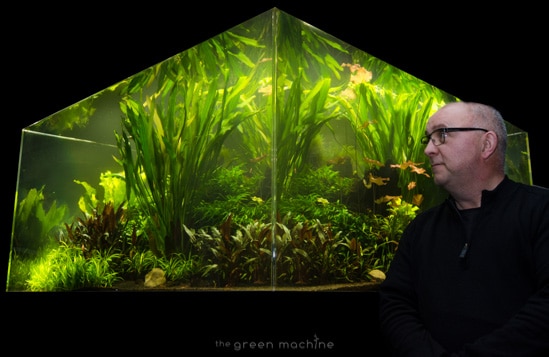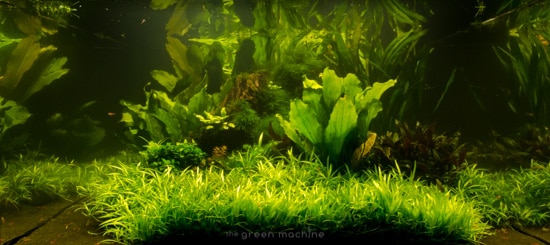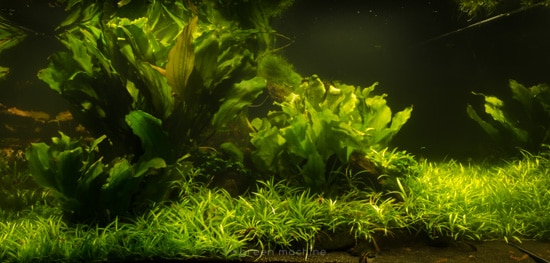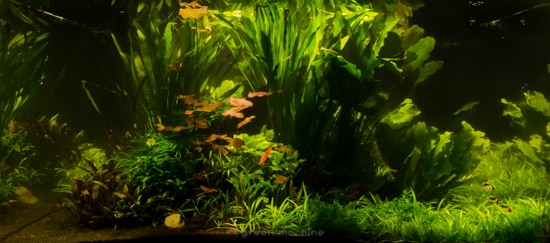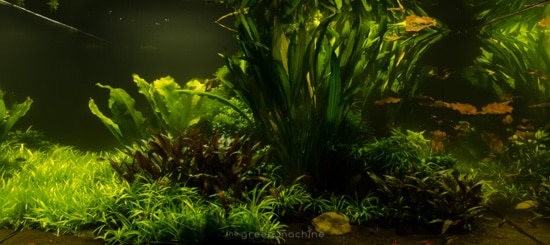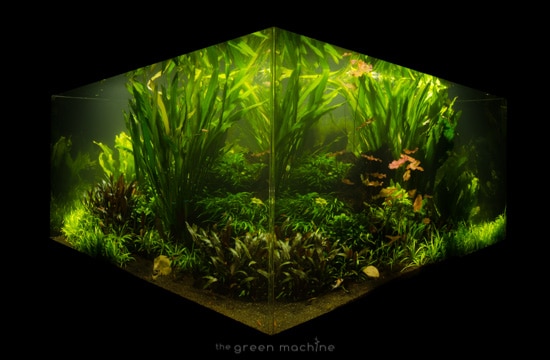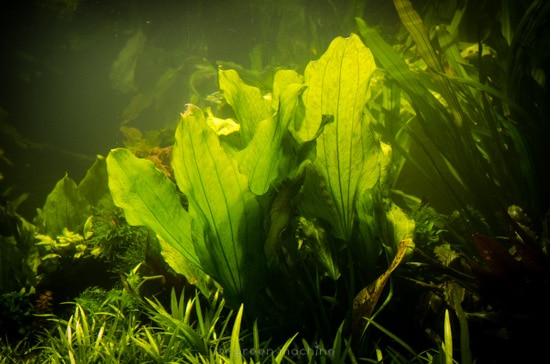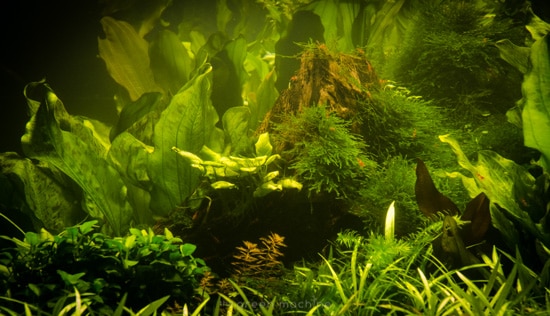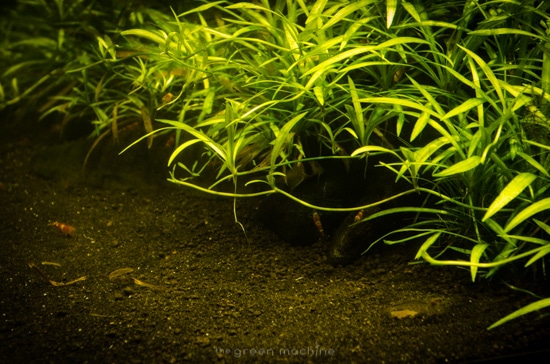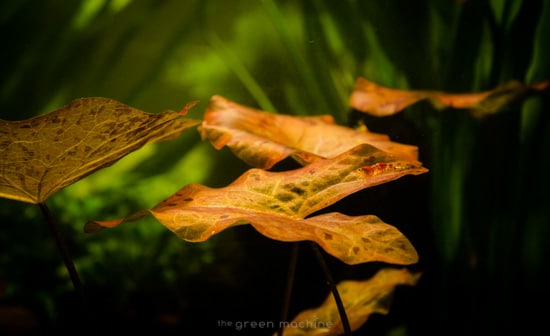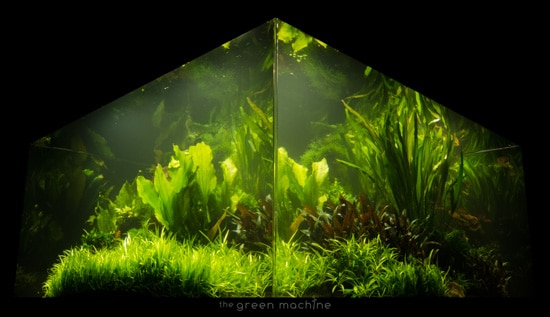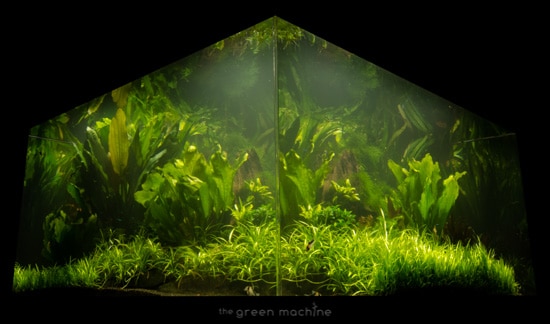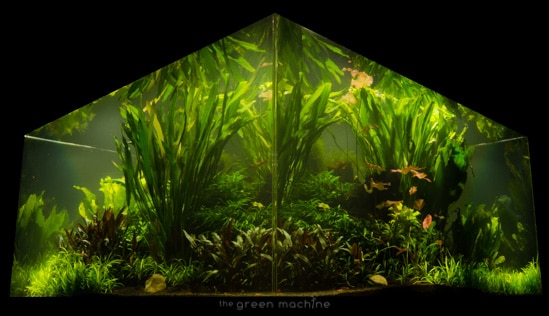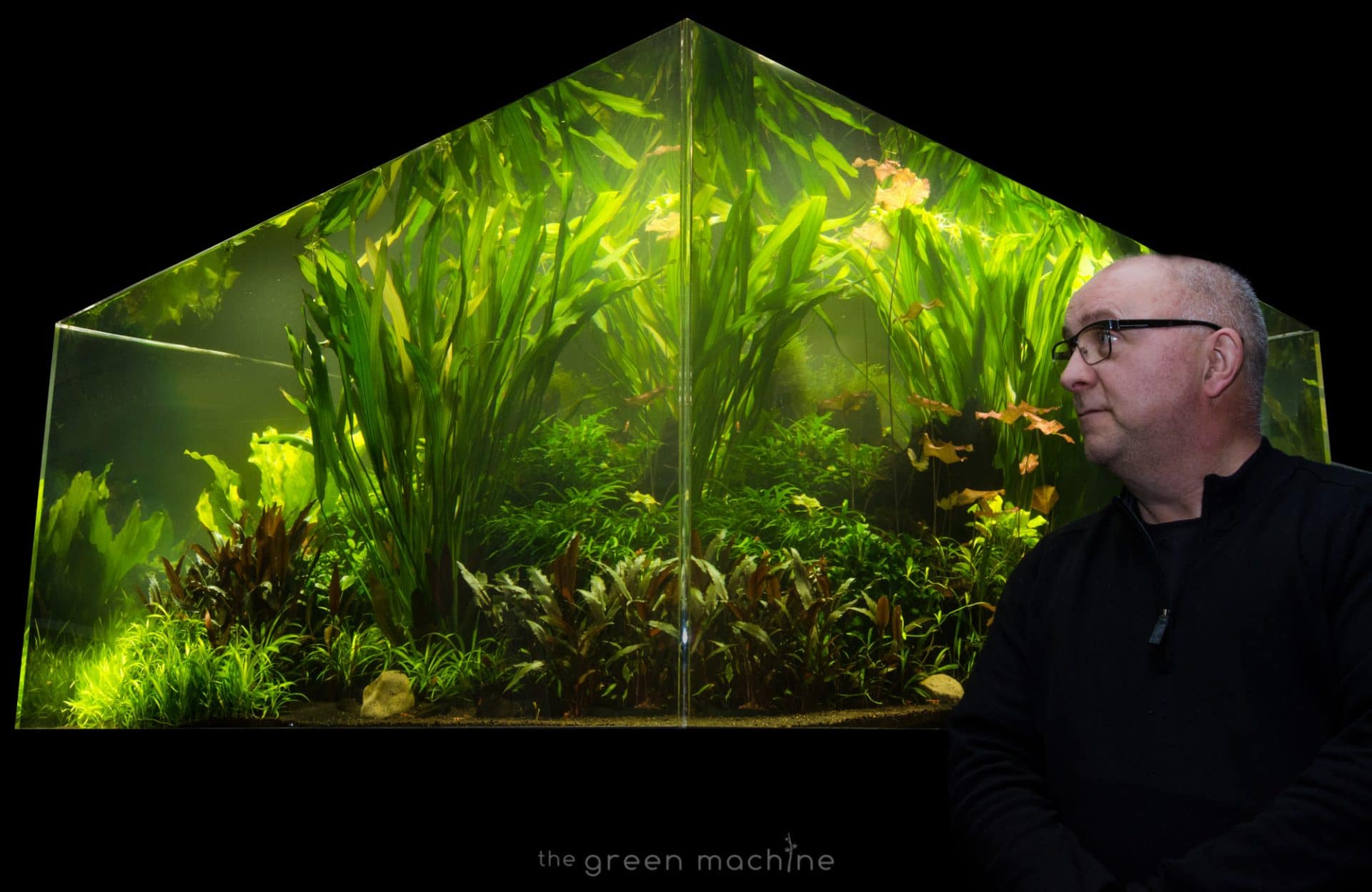
At 3 years old this super tank was transformed into a jungle style aquascape. The hardscape and substrate are the originals, only the plants were changed. It’s now 3.5 years old. This video explains why and how it was changed. You can also read the video transcript below the photos on this page.
The age of this tank is a testament to the longevity and high quality of ADA Aqua Soil – the ultimate substrate for your planted aquarium!
This is a follow up video to “The Making of Nature’s Chaos” 30 minute documentary and Nature’s Chaos 1 Year Old which can both be viewed here.
Here are some photographs of the new jungle layout…
Video Transcript
Welcome back to The Green Machine, the Nature Aquarium specialists.
Professional aquascaper James Findley founded The Green Machine in 2007 to bring nature aquariums to the UK. Part of his vision was to display huge super tanks in our gallery which would wow our visitors and inspire new generations of aquascapers.
This video will explain to you the transformation of one of James’ most talked about super tanks.
If you’ve watched some of our previous videos, browsed our website, or visited our shop, the aquascape you can see here may look familiar. That is because it is a partial reincarnation of James’ Nature’s Chaos volcano layout… the hardscape and substrate are the same as in the original design, only the layout of plants has undergone a major transformation.
Almost all space has been filled with large luscious wild looking plants- this style is aptly known as the Jungle style of planting. It is a more natural look than the minimal Japanese Nature Aquarium style- more of an authentic representation of a tropical riverbed- the natural habitat of the fish. It’s vastly different to the original volcano design.
1:19
But why was it changed?
James performed the transformation when the aquascape was three years old.
There were two main reasons for the change, firstly, James wanted to demonstrate how an aquascape can be completely transformed by changing only it’s plants. This is a cost effective way to dramatically change the look of your aquarium.
Secondly, James wanted to demonstrate the longevity of ADA Aqua Soil plant substrate. This aquarium is evidence of how aqua soil can beautifully support even high nutrient-needing plants such as Amazon swords and Cryptocorynes- up to 3 and a half years into the life of an aquarium, and beyond.
When starting your next planted aquarium, you can maximise your planted tank’s lifespan by using ADA Aqua Soil substrate.
This aquarium has a volume of approximately 1800 litres, and dimensions of 150cm x 150cm wide x 75cm high. It’s a free standing tank which can be viewed from a full 360 degrees. It is located in The Green Machine’s award winning gallery showroom along with other super tanks and numerous smaller nature aquariums, displays, and products.
Moving back in time, you can see how the aquascape looked just after the original planting was completed. You can see how plants are placed in key positions around the central volcano-like structure created by the large pieces of bogwood. There are spaces between each of the plants as they have not yet had time to grow in.
At the time of planting, aquascapers should have a vision of what the layout will look like when it matures and the plants have grown in. The volcano structure is easily recognisable at this stage.
Now we move forward in time, to one year into the life of the aquascape. You can see that the sand has been replaced by black sand, as originally intended by James, in line with the volcanic theme. The edges of the island have been softened by some new stones, giving a more natural look. You can see how the plants have developed over this period. They’ve grown in more fully, giving a more aged feel to the layout. The original plant locations are intact and the aquarium has fulfilled James’ original vision.
During the life of the aquarium James and his maintenance team conducted weekly water changes, as well as regular pruning where necessary. Careful attention was paid to plant fertilisation in order to nurture this layout over time.
4:06
Taking a look at the new jungle layout once more, the differences are easy to see. Can you make out the original piece of driftwood concealed behind the dense foliage?
The jungle style re-planting took just 1 day to complete.
First, fifty percent of the water was drained to make it easier to reach the substrate. Then the majority of plants were removed using pinsettes.
Once large areas of substrate had been cleared, James proceeded to add new species of plants.
Echinodorus quadricostatus was added as the main new foreground plant because of its rugged, bushy, jungle like growth. The effect is quite wild looking, you can see it reaching to the edges of the tank on the bottom of the layout.
Due to the great size of the tank James has used some of the larger swords to full effect;
These include Echinodorus ‘Ozelot’ and Echinodorus uruguayensis which is the tall thin one of which there are two that reach to surface of the water.
The largest is the sole Echinodorus ‘Red Special’ which has grown to huge proportions in this tank- approximately 60 centimetres wide and the same in height. This is similar to how it would grow and look in the wild.
There are still plenty of Green Neons that hide in the dense foliage. As well as lots of Crystal Red Shrimp who are always busy eating algae. You may spot some Ottocinculus grazing on algae, as well as some Corydoras adolfoi checking the soil for food.
The only maintenance that was conducted on the substrate during the life of the aquarium was the addition of one pot of ADA Multi Bottom Long and one pot of ADA Iron Bottom Long per year. These were pushed into the substrate in areas where plants needed more nutrients- especially near the edges where there is a thinner layer of substrate and therefore less nutrients than where the substrate is built up in the middle. These products slowly release nutrients into the substrate, providing the plants with what they need for healthy growth and prolonging the life of plant substrate. To find out more about them you can visit our website.
You may see that the water is a little cloudy, This is due in part to the large size of the aquarium- with larger aquariums you are looking through more water, so there is more sediment in the line of vision. This is one reason smaller aquariums often look clearer.
Another factor is that during maintenance work the jungle style layout makes it impossible to reach beneath the dense foliage to syphon sediment out of the aquarium, resulting in more sediment in the tank and water column.
The water could be made more clear with the use of more filtration, however as this aquarium is perfectly healthy already, it is only a matter of aesthetics, and slightly cloudy water is a more authentic jungle look.
Many people prefer the jungle style for this wild and naturalistic look. The fish certainly seem to enjoy having so many places to hide and explore.
One interesting result of using a large aquarium is that you find that the layout is made up of many smaller compositions… so when you look at small sections they look like mini aquascapes in their own right. Creating a planted tank on this scale can be very rewarding, as well as posing some unique challenges.
By re-planting this aquascape, the challenges were much less than if James had completely stripped down the aquarium and started again from scratch, and the process was much more inexpensive.
If you have a planted aquarium, perhaps you will consider re-planting when you are ready for a change?
8:48
James’ original title of “Nature’s Chaos” is perhaps even more fitting now, due to the dense new planting and bushy growth.
8:14
Here you can see the very large Echinodorus ‘Red Special’ on the left hand side of the tank, reaching to the surface of the water, the large Echinodorus Ozelot on the right hand side, and the original hardscape just showing behind the thick carpet of Echinodorus quadricostatus.
Here you can see a very tall thin Echinodorus uruguayensis on the right hand side.
A deep red clump of Cryptocoryne wendtii ‘Tropica’ acting as a mid ground plant below the large Echinodorus species. This red colour breaks up the green very effectively, giving great contrast within the layout.
9:40
Here both Uruguayensis can be clearly seen, mirroring each other on either side of the aquarium.
The floating deep red leaves of the Nymphaea lotus can be seen here not he right hand side.
To the left of those, in the centre of the aquarium, is a thick area of Microsorum pteropus ‘Trident‘ which forms a dense bed of green above the red of the Cryptocorynes.
We hope you’ve enjoyed this video, if you would like watch more videos you can browse our YouTube channel, and visit our website at www.thegreenmachineonline.com where you can access our free aquascaping articles and shop for all the products you could need for creating and maintaining your aquascape.
Like this article? Read more like this…
- ‘Escarpment’ Aquascape Journal
- ‘Reciprocity’ Aquascape by James Findley
- ‘Fallen Tree’ Aquascape by James Findley
- ‘Riverbank’ Aquascape by James Findley
- The Power of ADA – A 60-P Nature Aquarium
- The Power of ADA – An ADA Nature Aquarium
- The Power of ADA – A Do!aqua Nature Aquarium
- + Many more! – Explore our website!

